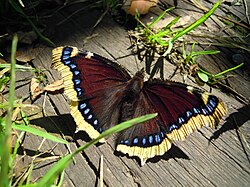Mourning cloak
| Nymphalis antiopa | |
|---|---|
 |
|
| Nymphalis antiopa. Upperside | |
 |
|
| Underside | |
| Scientific classification | |
| Kingdom: | Animalia |
| Phylum: | Arthropoda |
| Class: | Insecta |
| Order: | Lepidoptera |
| Family: | Nymphalidae |
| Genus: | Nymphalis |
| Species: | N. antiopa |
| Binomial name | |
|
Nymphalis antiopa (Linnaeus, 1758) |
|
| External identifiers for Nymphalis antiopa | |
|---|---|
| Encyclopedia of Life | 163165 |
| ITIS | 188597 |
| NCBI | 171592 |
| Also found in: | |
Nymphalis antiopa, known as the mourning cloak in North America and the Camberwell beauty in Britain, is a large butterfly native to Eurasia and North America.
The immature form of this species is sometimes known as the spiny elm caterpillar. Other older names for this species include grand surprise and white petticoat. A powerful flier, this species is sometimes found in areas far from its usual range during migration.
These butterflies have a life-span of 11 to 12 months, one of the most extensive life-spans for any butterfly.
It is also the State Insect of Montana, adopted in 2001.
In several European countries with Germanic languages, other than Britain, the name for this butterfly literally translates to "mourning cloak", such as German "Trauermantel", Swedish "sorgmantel", Finnish "suruvaippa" and Norwegian "Sørgekåpe". This suggests it is a name which came with Scandinavian or German rather than with British settlers, for whom this species would be considerably less familiar.L. Hugh Newman likened the butterfly's pattern to a girl who, disliking having to be in mourning, defiantly let a few inches of a bright dress show below her mourning dress.
The name originated from the discovery of two individuals at Coldharbour Lane in Camberwell in August 1748. Camberwell is in South London, about three miles south of London Bridge—in reporting this, the author Harris named the species grand surprise or Camberwell beauty (Bretherton & Emmet, 1990).
The mourning cloak butterflies are distributed broadly around the world. They are commonly found in North America and northern Eurasia, as well as in Mexico. Mourning cloak butterflies are prevalent throughout North America. They can usually be found in hardwood forests, though they have been found in virtually all habitats. They may also be found as far as the northern part of South America, though they are typically not seen as frequently in southern states such as Florida, Louisiana, or Texas. They are occasionally seen in the more temperate places in Asia, and a few have even been seen in Japan. However, the mourning cloaks tend to be found predominantly in cold, mountainous areas.
...
Wikipedia
